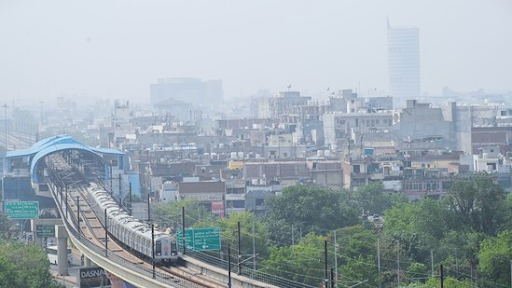.png) |
| Purebreeze |
Recent data from AQI India confirms that Delhi, Haryana, Punjab, and Rajasthan are currently experiencing the highest AQI levels, meaning residents face severe health risks. This blog explores these states' air pollution concerns, why it happens, its health impact, and possible solutions.
1. Delhi – India’s Most Polluted City
Current Reality
Delhi has long struggled with extreme air pollution, often ranking among the world’s most polluted cities. According to AQI India, Delhi’s Air Quality Index (AQI) levels are alarmingly high, posing severe health risks to residents.
Why Does It Happen?
- High vehicle emissions from millions of cars and motorcycles.
- Industrial pollution from nearby regions affecting Delhi’s air quality.
- Seasonal stubble burning in Punjab and Haryana worsens pollution levels.
Effects on Health
- Causes respiratory diseases such as asthma and bronchitis.
- Long-term exposure increases the risk of cardiovascular diseases.
- Severe pollution can lead to lung infections, affecting vulnerable groups.
Possible Solutions
- Implement stricter emissions standards for industries and vehicles.
- Improve public transportation to reduce private vehicle usage.
- Large-scale afforestation and pollution control policies.
2. Haryana – Industrial and Agricultural Pollution Crisis
Current Reality
Haryana faces a severe pollution crisis due to industrial emissions and agricultural activities. Air pollution levels are dangerously high, as shown by AQI India data, making living conditions unhealthy.
Why Does It Happen?
- Large-scale industrial activity emitting pollutants into the air.
- Stubble burning in Haryana and neighboring Punjab worsens AQI levels.
- Poor urban planning leads to high vehicular congestion and emissions.
Effects on Health
- Increased cases of chronic obstructive pulmonary disease (COPD).
- Higher risks of stroke, lung cancer, and heart disease.
- Reduced lung function in children and elderly residents.
Possible Solutions
- Strict penalties for stubble burning to encourage sustainable farming practices.
- Investment in industrial pollution control technology.
- Expansion of green spaces to improve air quality.
3. Punjab – The Heart of Stubble Burning Pollution
Current Reality
Punjab is a major agricultural hub but also one of the worst affected states when it comes to air pollution. Stubble burning causes thick smog, affecting not only Punjab but neighboring states like Delhi and Haryana.
Why Does It Happen?
- Farmers burn leftover crop stubble after harvest, worsening air pollution.
- Lack of alternatives and financial support for sustainable farming methods.
- Heavy industrial activity in some cities contributes to poor air quality.
Effects on Health
- High exposure leads to irritation in the eyes, throat, and lungs.
- Long-term inhalation can cause serious respiratory disorders.
- Smog reduces visibility, leading to more road accidents.
Possible Solutions
- Government incentives for farmers to adopt sustainable disposal methods.
- Encouraging mechanized stubble removal instead of burning.
- Strengthening pollution control laws in industrial areas.
4. Rajasthan – Desert Dust and Urban Pollution
Rajasthan’s air pollution problem is unique apart from industrial pollution, it also suffers from desert dust storms. According to AQI India, Rajasthan’s AQI levels are dangerously high, impacting both rural and urban populations.
Why Does It Happen?
- Wind-blown dust from the Thar Desert increases particulate matter concentration.
- Industrial emissions worsen pollution levels in cities like Jaipur and Udaipur.
- Poor waste management practices contribute to overall air degradation.
Effects on Health
- Dust particles cause eye infections, throat irritation, and respiratory problems.
- High AQI leads to increased cases of pneumonia and lung infections.
- Urban smog reduces oxygen levels, causing difficulty in breathing.
Possible Solutions
- Planting trees to reduce the impact of dust storms in Rajasthan.
- Strengthening industrial pollution laws to reduce emissions.
- Awareness campaigns to educate residents on pollution control practices.
Final Thoughts
According to the latest AQI India data, Delhi, Haryana, Punjab, and Rajasthan are currently the top four states battling extreme air pollution. Whether it's vehicle emissions, industrial pollution, crop burning, or desert dust storms, these regions face a serious health crisis.
However, solutions exist! With better urban planning, stricter pollution laws, and sustainable farming practices, India can fight back against air pollution and create a healthier future for its citizens.
Stay aware, advocate for change, and take personal steps to protect yourself from pollution.
Read More on Pollution:
Top Two states of India with Good AQI for Healthy Living
If you live in Delhi you must have this in your home for longevity



.png)
.png)


.png)
.png)